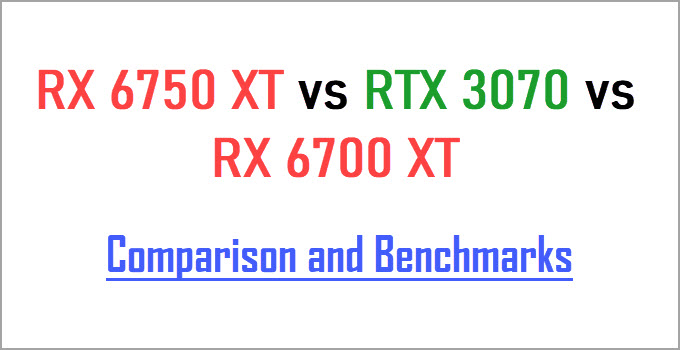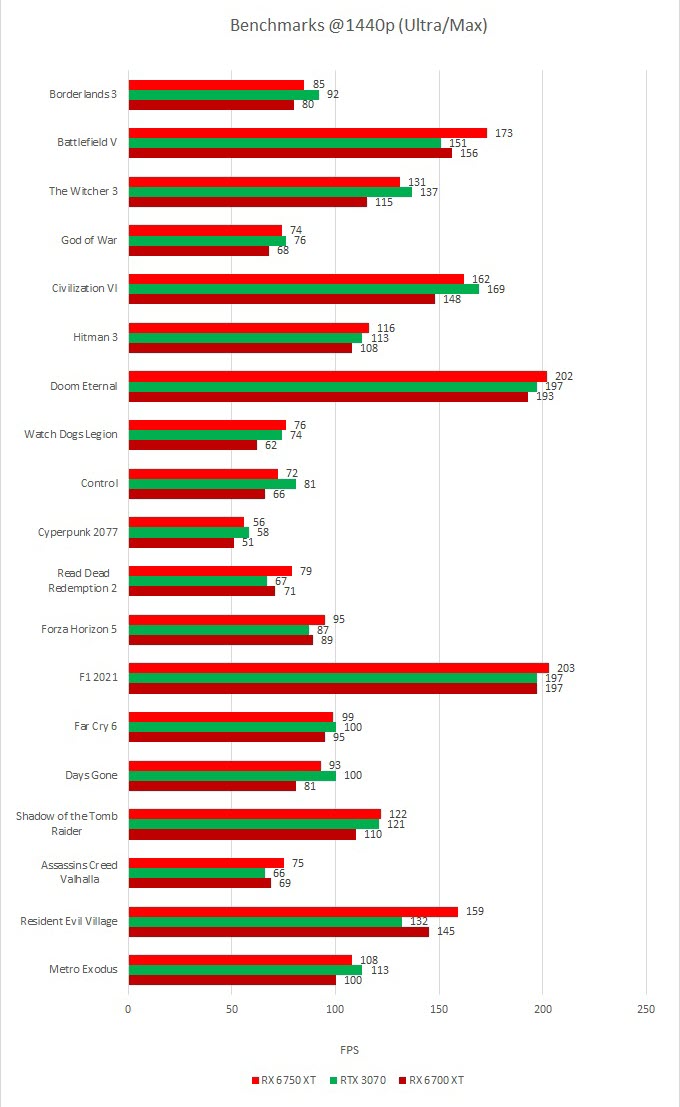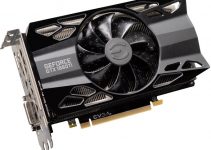Radeon RX 6750 XT is one of the newer graphics cards released by AMD in its Radeon RX 6000 series lineup. It is a refresh of RX 6700 XT and comes with higher GPU and memory clock speeds while other specifications remain almost the same. The card sits above the RX 6700 XT in the Radeon RX 6000 graphics card series. The main competitor of RX 6750 XT is the GeForce RTX 3070 from Nvidia and the card also faces the competition from RX 6700 XT itself. So, if want to know how the newer RX 6750 XT performs against its major competitors then in this post, I will be comparing the card against the RTX 3070 and RX 6700 XT based on various important parameters along with the gaming benchmarks.

RX 6750 XT vs RTX 3070 vs RX 6700 XT Comparison
Below is the comparison between RX 6750 XT, RTX 3070, and RX 6700 XT graphics cards based on their specifications, performance, pricing, power consumption, and features.
GPU Architecture
RX 6750 XT and RX 6700 XT cards are powered by RDNA 2 GPU architecture and are built on the 7nm manufacturing process. Both the cards use Navi 22 XT GPU chip and come with 2560 Stream Processors, 40 Ray Accelerators, or Ray Tracing Cores. The GPU Boost Frequency of RX 6750 XT is 2600 MHz, and that of RX 6700 XT is 2581 MHz.
On the other hand, RTX 3070 is built on the Ampere GPU architecture on the 8nm manufacturing process. The card uses a GA104 GPU chip and comes with 5888 CUDA Cores, 46 Ray Tracing Cores, and 184 Tensor Cores for AI (artificial intelligence) processing or tasks such as DLSS.
| RX 6750 XT | RTX 3070 | RX 6700 XT | |
| GPU Chip | Navi 22 XT | GA104 | Navi 22 XT |
| GPU Architecture | RDNA 2 | Ampere | RDNA 2 |
| Fabrication Process | 7nm | 8nm | 7nm |
| CUDA Cores/Stream Processors | 2560 Stream Processors | 5888 CUDA Cores | 2560 Stream Processors |
| Ray Tracing Cores | 40 | 46 | 40 |
| Tensor Cores | NA | 184 | NA |
Video Memory [VRAM]
RX 6750 XT and RX 6700 XT come with 12GB GDDR6 memory having a 192-bit interface but having different speeds. The memory of RX 6750 XT runs at 18 Gbps delivering a memory bandwidth of 432 GB/s while RX 6700 XT runs at 16 Gbps delivering bandwidth of 384GB/s. Both the cards come with 96MB Infinity Cache, an ultra-fast cache present on the GPU that is used to achieve a higher peak memory bandwidth. On the other hand, RTX 3070 comes with 8GB GDDR6 memory having a 256-bit interface. The memory runs at a speed of 14Gbps and produces a bandwidth of 360 GB/s, which is higher than the two Radeon cards here if we only take into account effective memory bandwidth.
| RX 6750 XT | RTX 3070 | RX 6700 XT | |
| Memory Size | 12 GB GDDR6 | 8 GB GDDR6 | 12 GB GDDR6 |
| Memory Interface | 192-bit | 256-bit | 192-bit |
| Memory Speed | 18 Gbps | 14 Gbps | 16 Gbps |
| Memory Bandwidth | 432 GB/s | 448 GB/s | 384 GB/s |
| Infinity Cache | 96MB | NA | 96MB |
Features
All three cards are quite similar and support almost all the latest technologies. All of them support DirectX 12 Ultimate, OpenGL 4.6, Vulkan, PCI-Express 4.0, Real-Time Ray Tracing, HDMI 2.1, AV1 decode, Resizable BAR, Microsoft DirectStorage API (to reduce game loading times), variable refresh rate technologies G-Sync/FreeSync to reduce game stuttering. There is no SLI/CrossFire multi-GPU support for these cards. Nvidia GeForce RTX 3070 supports DLSS 2.0 (Deep Learning Super Sampling) which is a next-generation AI rendering and image scaling technology to increase gaming performance or FPS in supported games without any major compromise in image quality. On the other hand, RX 6750 XT and RX 6700 XT support AMD FidelityFX Super Resolution (FSR) which is an AMD implementation of image scaling technology to improve performance in games with a slight compromise on image quality.
| RX 6750 XT | RTX 3070 | RX 6700 XT | |
| Bus Interface | PCI Express 4.0 | PCI Express 4.0 | PCI Express 4.0 |
| DirectX | 12 Ultimate | 12 Ultimate | 12 Ultimate |
| OpenGL | 4.6 | 4.6 | 4.6 |
| Vulkan | 1.2 | 1.2 | 1.2 |
| SLI/CrossFire | No | No | No |
| VR Ready | Yes | Yes | Yes |
| G-Sync | Yes (FreeSync) | Yes | Yes |
| HDMI 2.1 | Yes | Yes | Yes |
| AV1 Support | Yes | Yes | Yes |
| Real-Time Ray Tracing | Yes | Yes | Yes |
| Deep Learning Super Sampling | NA | Yes | NA |
| AMD FidelityFX Super Resolution (FSR) | Yes | NA | Yes |
Gaming Performance
Here are the gaming benchmarks of these cards at 1440p resolution.
1440p Benchmarks

From the above benchmarks, it is quite evident that RX 6750 XT performs almost the same as RTX 3070. In some games, RX 6750 XT takes the lead and in some RTX 3070 is faster. When compared to RX 6700 XT, RX 6750 XT is around 8% faster on average and beats it in all games.
Power Consumption
The power consumption of RX 6750 XT stands at 250W, RX 6700 XT at 230W, and RTX 3070 at 220W. RTX 3070 is the most power-efficient card here while RX 6750 XT is the least.
| RX 6750 XT | RTX 3070 | RX 6700 XT | |
| Power Consumption | 250W | 220W | 230W |
| Recommended PSU | 650W | 650W | 650W |
Pricing and Availability
The base MSRP of these cards is as follows; RX 6750 XT is priced at $549, RX 6700 XT at $479, and RTX 3070 at $499. The custom models of these cards may cost more depending on the features offered and the cooling solution used. You can check the current prices of these graphics cards from the links given below.
Check RX 6750 XT Price on Amazon
Check RTX 3070 Price on Amazon
Check RX 6700 XT Price on Amazon
RX 6750 XT vs RTX 3070 vs RX 6700 XT Specifications
| RX 6750 XT | RTX 3070 | RX 6700 XT | |
| GPU Chip | Navi 22 XT | GA104 | Navi 22 XT |
| GPU Architecture | RDNA 2 | Ampere | RDNA 2 |
| Fabrication Process | 7nm | 8nm | 7nm |
| CUDA Cores/Stream Processors | 2560 Stream Processors | 5888 CUDA Cores | 2560 Stream Processors |
| Ray Tracing Cores | 40 | 46 | 40 |
| Tensor Cores | NA | 184 | NA |
| Memory Size | 12 GB GDDR6 | 8 GB GDDR6 | 12 GB GDDR6 |
| Memory Interface | 192-bit | 256-bit | 192-bit |
| Memory Speed | 18 Gbps | 14 Gbps | 16 Gbps |
| Memory Bandwidth | 432 GB/s | 448 GB/s | 384 GB/s |
| Bus Interface | PCI Express 4.0 | PCI Express 4.0 | PCI Express 4.0 |
| DirectX | 12 Ultimate | 12 Ultimate | 12 Ultimate |
| OpenGL | 4.6 | 4.6 | 4.6 |
| Vulkan | 1.2 | 1.2 | 1.2 |
| SLI/CrossFire | NA | NA | NA |
| VR Ready | Yes | Yes | Yes |
| G-Sync/FreeSync | FreeSync | G-Sync | FreeSync |
| Power Consumption | 250W | 220W | 230W |
| Recommended PSU | 650W | 650W | 650W |
See also:
Final Thoughts
Well, RX 6750 XT has reduced the performance gap between RX 6700 XT and RTX 3070 as it is as fast as the RTX 3070. However, the downside is that it is the costliest card here and also the one with the highest power consumption. There is no doubt that RX 6750 XT delivers great performance at 1440p gaming and you can also enjoy high-end 4K gaming by trimming down some graphics settings depending on the game. Overall, RX 6750 XT is a good card but it does consume significantly more power than RX 6700 XT and also costs a bit more. If you have opinions or questions regarding the RX 6750 XT or its competitors then do let me know in the comment section below.
(*This post may contain affiliate links, which means I may receive a small commission if you choose to purchase through the links I provide (at no extra cost to you). Thank you for supporting the work I put into this site!)



Hello sir!
What gpu should i buy right now?
Is amd cards worht to get? They are cheaper now
And which 6750 xt better?
XFX Speedster MERC319 for 550$ or
PowerColor Red Devil for 580$
Thanks for the info you doing great job
And which gpu best for price around 600$ right now in your opinion?
Yes, the current generation RDNA 2 AMD cards are totally worth getting. They offer excellent performance for the price and AMD driver support has is getting better. For under $600, RX 6750 XT is a great card for 1440p and even 4K gaming. Both XFX and PowerColor models are good. I would buy the cheaper one or the one that has better support/service in my area. Hope that helps!